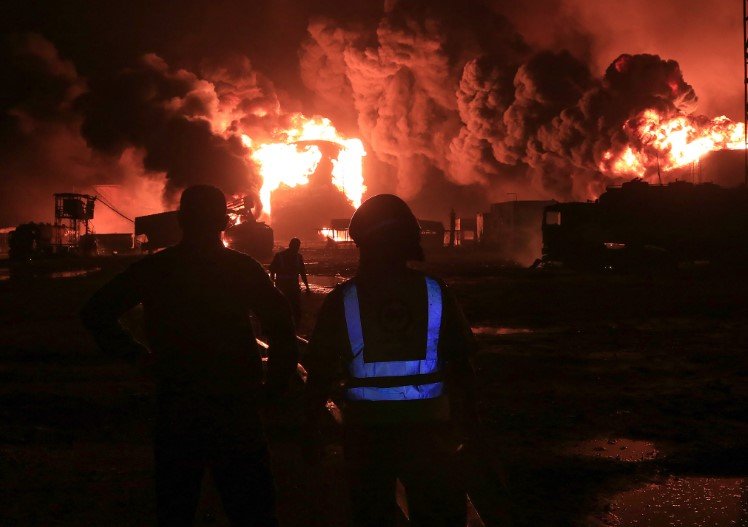Houthis vow further drone attacks on Israel unless Gaza siege ends; Israel claims Hodeidah is key weapons gateway
Israel confirmed Monday it had launched multiple airstrikes on the Red Sea port of Hodeidah in Yemen, targeting what it called “Houthi-linked terror infrastructure” amid escalating tit-for-tat attacks between Tel Aviv and the Iran-backed group.
The strikes mark one of the most direct escalations yet between Israel and Yemen’s Houthis since the start of the Gaza war, and signal that the regional fallout from that conflict is now openly stretching hundreds of miles beyond Israel’s immediate borders.
A Message Delivered by Missiles — on Both Sides
The Israeli military said the strikes targeted “military assets used to store and launch drones and missiles against Israel and its allies.” The air raids, which reportedly took place late Sunday into early Monday, hit areas near key dock facilities in Hodeidah, a port city controlled by the Houthis.
“We are forcefully countering any attempt to restore the terror infrastructure previously attacked,” Defense Minister Israel Katz said in a statement. “Anyone who threatens Israel from afar will be met with decisive response.”
Shortly after the strikes, the Houthis claimed responsibility for launching fresh drone and missile barrages toward several Israeli cities, including Tel Aviv, Jaffa, and Ashdod. Though Israel’s Iron Dome and David’s Sling defense systems intercepted the majority of incoming fire, the symbolism was clear: the war is no longer confined to Gaza.

Why Hodeidah Matters
Hodeidah isn’t just another Yemeni city — it’s a lifeline. The port, on Yemen’s Red Sea coast, is critical for food, fuel, and humanitarian aid delivery to millions of civilians, especially in the north.
But Israel claims it has also become a military supply hub for the Houthis, receiving Iranian weapons and housing drone-launching infrastructure.
That assertion, while difficult to independently verify, has been echoed by U.S. intelligence assessments since early 2024. Both American and Israeli officials say Iranian support for the Houthis has grown increasingly sophisticated — and aggressive — in recent months.
And Hodeidah has played a central role. According to a regional diplomat familiar with the intelligence briefings, the port “has been transformed into a dual-use zone — humanitarian on the surface, military underneath.”
Still, that dual-use claim has led to international concern about Israel’s targeting of a facility so vital to Yemen’s war-ravaged population.
The Houthis Aren’t Bluffing
The Houthis aren’t just claiming symbolic victories. Since December 2023, they’ve launched dozens of drones and missiles toward southern Israel, the Gulf of Aqaba, and even Red Sea shipping lanes, prompting U.S. and UK naval patrols to ramp up.
And the group’s spokesman, Yahya Saree, doubled down Monday after the latest Israeli strikes.
“We will continue our attacks until the occupation ends and the siege on Gaza is lifted,” he said in a televised statement. “Israel will not enjoy security while our brothers in Palestine are slaughtered.”
That rhetoric, once dismissed by Israeli security officials as bluster, is now being taken seriously. Analysts believe the Houthis have gradually shifted from regional proxy to active combatant in the Gaza war’s wider arena.
What This Means for the Red Sea Shipping Crisis
It’s not just about missiles and ideology anymore. The Israeli-Houthi confrontation is reshaping the economic geography of the region.
The Bab el-Mandeb Strait — through which an estimated 10% of global trade flows — has already seen major disruptions. Maersk, Hapag-Lloyd, and other shipping giants have rerouted vessels around the Cape of Good Hope, adding up to two weeks of travel time and millions in costs.
And Monday’s strikes could signal more instability to come. Israel’s decision to hit port infrastructure in Hodeidah — even if limited to military targets — risks drawing further attacks on Red Sea commerce.
Here’s what’s changed over the past six months:
| Month | Houthi Actions | Israeli/U.S. Response |
|---|---|---|
| January 2025 | Began targeting Red Sea shipping | U.S. launches Operation Prosperity Guardian |
| March 2025 | Strike on Eilat intercepted | Israel increases Iron Dome units in south |
| May 2025 | Drone lands near Tel Aviv suburb | Israeli airstrike in Saada province |
| July 2025 | Missile barrage on Ashdod & Jaffa | Israel bombs Hodeidah port |
Gaza Is Still the Epicenter — but No Longer the Only Front
While attention remains fixed on Rafah and Khan Younis, Israeli officials have become increasingly vocal about what they see as the “Iranian crescent” forming across Syria, Lebanon, Iraq, and Yemen.
The Israeli cabinet met in a closed session on Monday night to discuss the fallout from the Hodeidah strikes. Though details were sparse, one participant said the mood was “tense but unified.” There’s little appetite for a long war in Yemen — but even less for unchecked missile fire from the south.
Prime Minister Benjamin Netanyahu has yet to comment publicly on the operation. But Defense Minister Katz hinted at further action to come.
“No location is out of reach. No terrorist is untouchable,” he said.
The Humanitarian Alarm Bells Are Ringing
Unsurprisingly, the strikes on Hodeidah have alarmed aid groups.
The World Food Programme, Doctors Without Borders, and the UN Office for the Coordination of Humanitarian Affairs all warned Monday that further damage to port facilities could push Yemen — already on the brink — into a full-scale famine.
Rania Kisar, a Syrian-American humanitarian who has worked in both Gaza and Yemen, warned that “targeting ports is a dangerous escalation. Even if Israel says it’s hitting military assets, you’re also risking food, fuel, and medicine flows.”
Still, for Israeli officials, the calculus appears unchanged: stop the missiles, regardless of geography.
